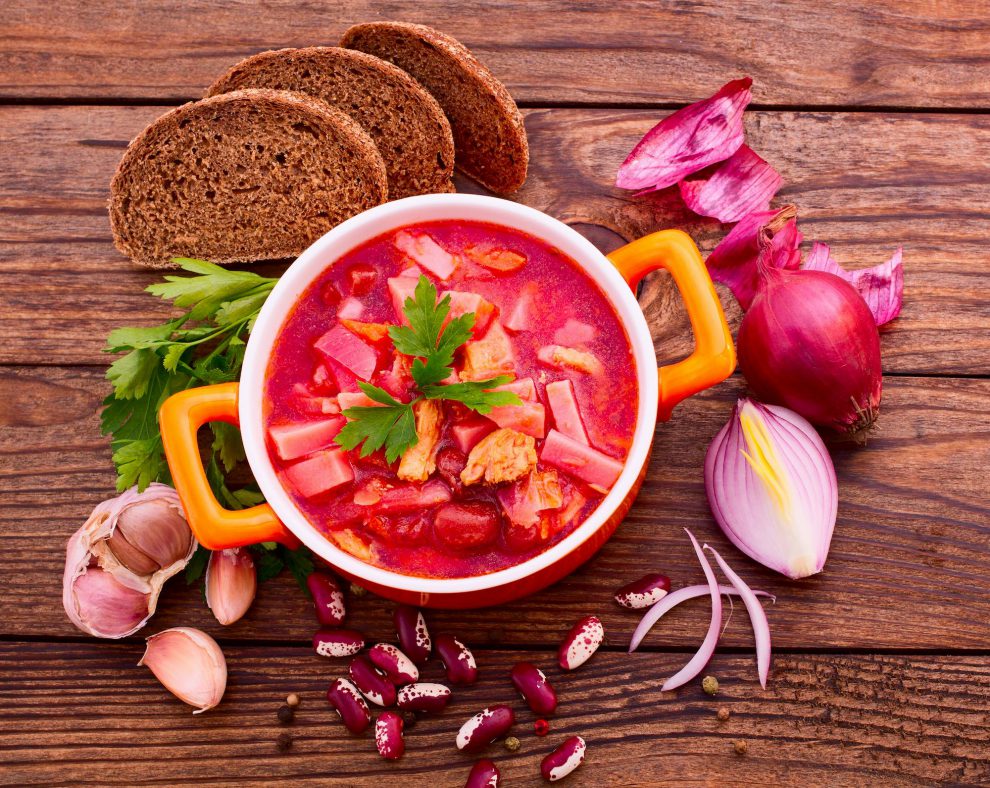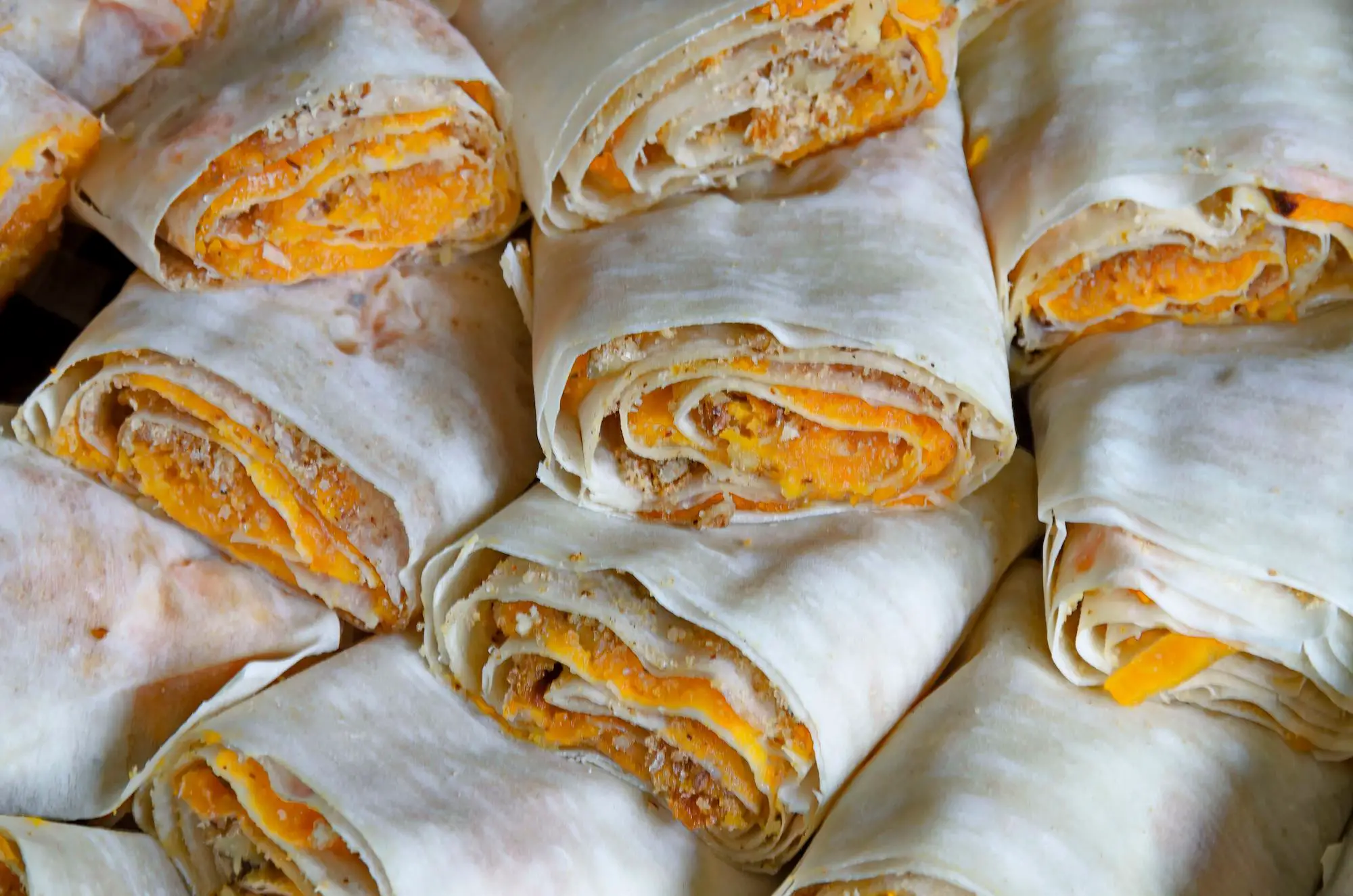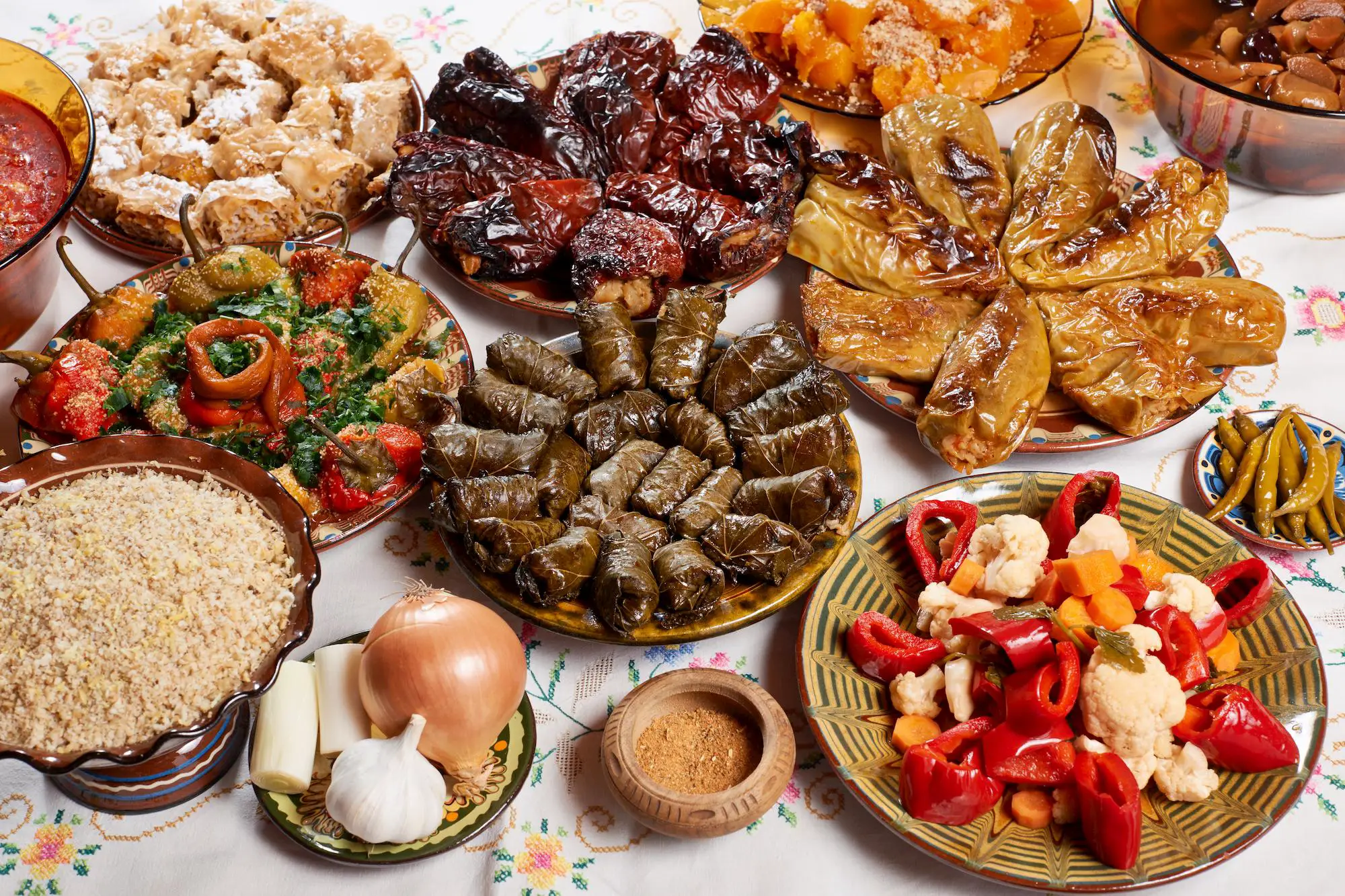Russian cuisine is versatile, and its specialties and flavors vary depending on the specific region and its residents. This cuisine was shaped by the different impacts of history and religion, lifestyle, geographical regions, and harsh climate.
Most of the traditional Russian dishes are high in carbs and fat to keep you warm during winter, but among these are also lighter delicious meals and desserts that can be a real, nutritious refreshment during hot summer days.
Russian food is made of simple ingredients that are well combined in numerous savory dishes and desserts, served with vodka, wine, or tea.
Here is a list of 20 traditional Russian foods that have remained evergreen over time and never fail to remind Russians of their homeland when served.
Table of Contents
1. Pirozhki
Pirozhki are popular street food in Russia but also a perfect breakfast choice. These buns are made of yeast dough that is generously filled either with jam or/ and cottage cheese or with minced meat, rice, vegetables, and fish as savory options [1].
Pirozhki are also prepared in many countries throughout Southeastern Europe and can be often found as a snack or starter on menus in restaurants or pubs.
2. Solyanka
Solyanka is one of the best known traditional Russian soups after the ever-popular Borsch.
The Solyanka is made with a variety of vegetables as a base (onions, cabbage, tomatoes, olives) and meat (beef, pork or poultry), mushrooms, or fish.
Solyanka is served hot with lemon, sour cream, and ground pepper on the side.
3. Golubtsy
Golubtsy is the traditional Russian version of cabbage rolls stuffed with minced meat and rice, commonly found on the menu of other cuisines such as the Middle and the Southeastern.
A fun fact about this dish is that its name originally means “little pigeons” and it refers to a much favored culinary practice by the Russian aristocrats in the 18th-century grilling pigeons.
Since the lower social class couldn’t afford pigeons as food, they cooked these cabbage rolls, which has the same shape as pigeons or “golubtsy” and ate them as an alternative.
Related post: Polish Foods You Need to Try
4. Borscht Soup
Borscht is one of the main associations with Russia after vodka. This popular soup is made of beetroot, cabbage, onion, carrots, tomatoes, and garlic, and usually, beef chunks are added to it.
A portion of perfect comfort food to enjoy during cold winter days served with sour cream and a piece of bread on the side.
5. Salat Olivye
A traditional potato salad that can also be found under the name of “Russian Salad” in Ukraine or in the Balkans. Salat Olivye is prepared for special celebrations and festivities, and it is “a-must” at New Year’s or Christmas celebrations in Russia.
The main ingredients in this salad are boiled potatoes, carrots, peas, and eggs, combined with diced ham, pickled cucumbers, chopped dill, and parsley, all mixed together with a generous amount of mayonnaise. Black pepper is added for a more intense flavor.
6. Medovik
Medovik is a mouthwatering layered cake made of honey biscuit cake layers covered with custard ream made of yolks, condensed milk, and butter.
According to historical records, Medovik has royal origins as it was first made for the Russian Tzaritza, the wife of Alexander I of Russia. Today, Medovik is usually served on special occasions, but it can also be found in international patisseries around the world.
7. Blini
Blini are the Russian version of the widely popular French crepes—a thin, fried layer of pastry made of eggs, milk, water, and flour.
Blini are usually sold as street food, but they are also a common choice for breakfast, filled with fresh fruit, honey, jam, or chocolate spread. Savory versions include fillings of minced meat and onion, potatoes, fried vegetables, cabbage, etc.
8. Kholodets
Kholodets is a traditional snack or starter food that is usually enjoyed with vodka.
Kholodets is a meat jelly made of consomme, a clear soup made with concentrated stock, with chunks of meat (pork or beef) and vegetables such as carrots, parsley, or garlic. It is served cold.
9. Pelmeni
Pelmeni are Russian dumplings made of stretchy dough that resembles Italian pasta. The dough is filled with minced meat, mushrooms or potatoes, and herbs.
Pelmeni are usually shortly cooked in boiling water and then served with sour cream on top, though there are fried versions as well.
10. Vatrushka
Vatrushka is a dessert-pastry that can eventually be found in savory versions as well. Its traditional version includes a filling of cottage cheese and raisins or jam or minced meat.
Vatrushka is baked and best when eaten straight out of the oven. This pastry is popular not only in Russia but also in Belarus and in Ukrainian cuisine, and it can be found in every bakery in these countries.
11. Beluga Caviar
Beluga Caviar is one of the most precious caviars in the world. It is an extremely rare, exclusive, and immensely expensive appetizer due to the fact that it is made by roe produced after 25 years of maturation.
The beluga caviar beads have a tender, buttery texture that produces a delicious flavor with a delicate finish.
In general, the Beluga Caviar is served along blini, cour cream, or cooked potatoes. However, the high price of this rare product serves it only on plates of first-class restaurants.
12. Syrinki
Syrinki is a dish that can be served either as a quick, simple dessert, or it can replace pancakes at breakfast.
Syrinki are made of cottage cheese, eggs, flour, some sugar, and salt, all mixed together and fried in hot oil. If you prefer the good, old sweet version, you increase the amount of sugar in this recipe, or if you are up for a savory one, then you add some more salt.
Nevertheless, syrinki are best served hot with fruit jam, honey, powdered sugar, or fresh chunks of fruit on top, with a cup of tea or milk on the side.
13. Shashlik
Traditional grilled marinated chunks of pork, lamb, or beef skewered and paired with vegetables such as mushrooms, onions, peppers, and tomatoes.
The meat chunks are marinated in wine, vinegar, herbs, salt, spices, and oil and left to soak overnight. The next day, Shashlik is usually prepared by several family members who participate in the grilling process and socialize either with their family or friends.
Though by large present in Russian cuisine, Shashlik is also considered as a traditional culinary element in the wider region of both West and Central Asia, originating from Turkey.
14. Beef Stroganoff
Beef Stroganoff is a Russian national dish that was created in the 19th century. It is made of sauteed beef chunks that are cooked in a light sauce made of sour cream, mustard, and stock.
The origins of Beef Stroganoff are associated with a French chef who worked for the popular Russian Stroganoff family. The French influence in this dish is translated in the cutting technique of the meat and the use of mustard in the creamy sauce.
15. Stroganina
This dish is the Russsian variant of what it’s commonly known as sashimi. Stroganina is a raw frozen fish that is served in very thin curled slices while still frozen.
Stroganina is a dish that has thrived in Russian culture for hundreds of years. Though raw fish and meat may not be very common in a number of cultures around the world, it is a product that provided survival through extremely harsh winters of many people in the Russian Arctic for centuries.
The birthplace of Stroganina is Novosibirsk, where it is prepared with different kinds of whitefish such as nelma or muksun.
Stroganina is served on ice with a shot of ice-cold vodka on the side.
16. Ptichye Moloko
Ptichye Moloko is a delicious dessert listed among common Russian food on menus. The name of this Russian cake may leave you with question marks above your head, as it is definitely not what it means.
Ptichye Moloko is a thick piece of sponge cake topped with a foamy jello layer then covered with chocolate. Though it seems simple, it is considered one of the best Russian desserts that were created during the Soviet era.
Inspired by the French marshmallow, Ptichye Moloko was made by the patisserie chef Vladimir Guraljnik who is a legend in Russian confectionery and the creator of one of the most famous Russian dishes.
17. Smetanik
This cake is a traditional Russian layered cake. The main ingredients for the cake layers are flour, eggs, sugar, and honey, whereas the white frosting is made of cream cheese, milk, sugar, vanilla, and sour cream.
The popular shape of this cake is provided by baking in a very deep cake pan. Three layers of dough are baked, then cut into two pieces and covered with a filling of frosting cream between each.
The typical traditional Smetanik is topped with ground walnuts or chocolate, but fresh berries or any preferred fruit chunks are also an option.
18. Oladyi
According to an old Russian saying, you may not feed the whole world with Blini or Oladyi, but you will bring joy in the hearts of your family and friends.
Oladyi are the short but nonetheless equally tasty version of the famous Blini. The dough of these small pancakes is full of flavor because they are prepared with kefir, a fermented sour dairy product that resembles yogurt.
Flour, eggs, some sugar, and salt are added to the kefir, then all these ingredients are mixed and the batter in pan-fried in the round shape of the well-known American pancakes.
When they become golden brown, that means they’re ready to be served. Their center is soft and chewy, while the edges are harder and crunchy. The Oladyi can have a predominant sour or sweet taste, depending on preferences but are distinguished by their sour kefir taste.
Serve them with fruit preserves, honey, sour cream, chocolate, fresh fruit, or cheese for breakfast or quick dinner.
19. Pastila
The history of this sweet typical Russian food is related to Russian merchants who had close trading relations to the Near East, so they introduced a product that resembles Rahat or Turkish Delight.
However, the ingredients of this dessert that initially appeared in Russia in the 16th century are quite basic- egg whites, honey, sugar, and fruit.
The Pastilla can be described as a cross-version of Turkish Delight and meringue cake. Different types of fruit are used for the making of this dessert, yet sour apples and berries are most common. The most popular type is the Kolomensky pastila from the ancient city of Kolomna.
Pastilla is usually served as a dessert at the end of meals though it can also be consumed as a snack with a cup of tea or coffee.
20. Guriev kasha
Guriev kasha is more than a typical semolina porridge. The preparation of this traditional Russian recipe includes several original steps, including baked milk or cream in the oven until a semi- golden crust is made on the top.
Historical records tell two stories about the origin of Guriev kasha. The first one goes back to the early 19th century when Count Dmitri Guriev prepared it as a festive food to celebrate victory over the army of Napoleon. The second story is related to the royal chef of Count Guriev, who created the kasha in his honor and served it as dessert whose recipe was kept secret for many years.
The creamy crust is then used to separate the layers of porridge. Between the milk crust layers of nuts, jam, fruit, or nuts & dried fruit are added then covered with an additional semolina layer. The Guriev kasha is then sprinkled with powdered or confectioners sugar and then baked until the top becomes crispy.
Though Guriev kasha may seem like breakfast food to many, don’t let its simple looks fool you- this century-old dish was served during the coronation of Tsar Alexander III in the 19th century, and today it is prepared for special occasions and celebrations.













